
| This story was printed in the April 2010 issue of "On Track", a newsletter published by the Railway Society of Southern Africa (RSSA). |
 |
| The south-western region of South Africa |
If you enjoyed reading this, please send me an email. All correspondence is appreciated!
[Friday 9 January 2009] Our party of five met at the Premier Classe lounge alongside platform 24 at Cape Town station at about 2 PM on Friday, a typically hot and windy mid-summer afternoon. Charming hostesses served us tea and coffee until it was time to board the train. We had booked three compartments, two doubles and a single all next to each other, and we wondered whether Shosholoza Meyl would manage this complicated arrangement [Aside : "Shosholoza Meyl" is the name of the division within the Passenger Rail Agency of South Africa (PRASA) that runs all passenger rail services in the country].
However, we needn't have worried, because our three compartments were exactly as we'd requested. The compartments themselves were immaculately fitted-out, with soft duvets and pillows, crisp white sheets, complimentary bottled water, fluffy towels and even robes and slip-slop sandals for going to the shower. The double compartments were the same size as those on standard South African inter-city trains that usually sleep four (and sometimes six), but on the Premier Classe contained only two bunk beds ; the single compartment was half this size with one bunk bed. There was a toilet at each end of the coach and a shower. It wasn't perhaps up to Rovos Rail or Blue Train ultra-luxury standards, but it was obvious that we were going to be extremely comfortable.
The configuration of the train was as follows : a lounge car and a kitchen car in the middle, two dining cars (one on either side of the lounge/kitchen cars) and several sleeping cars on each side of the dining cars. This was a pretty good arrangement - the people in the front sleeping cars had their meals in the front dining car and the people at the back used the rear dining car, so nobody had to walk very far.
| Scenes from the Premier Classe train ... |
 |
| Tea and cake in the lounge car |
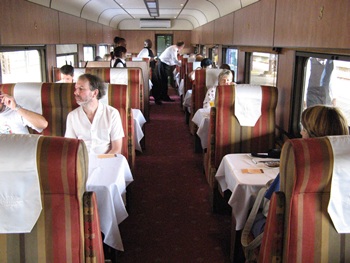 |
| Lunch in the dining car |
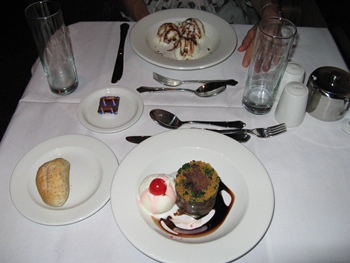 |
| Enjoying dessert after dinner |
The train pulled slowly out of Cape Town station just after 3 PM (about 15 minutes late) and headed north-east through Cape Town's sprawling northern suburbs, past the ever-expanding Century City complex (where a new MetroRail station was being constructed ; for more details, read this blog) and on to Bellville. Shortly after departure a steward came round and requested that all passengers meet in the lounge car. When we got there we were served more tea and coffee, as well as chocolate and carrot cake, and then the on-board train manager explained the logistics of the trip to Port Elizabeth - meal times, arrival times, etc.
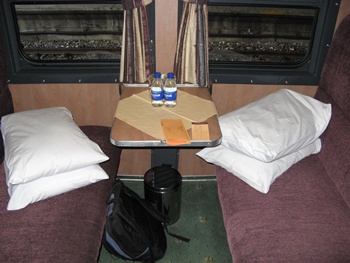 |
| A Premier Classe double compartment |
After Bellville we continued towards Worcester without stopping at any of the suburban stations on the way ; most of these stations looked well-kept and clean. This section is on the mainline track that extends all the way north to Beit Bridge on the Zimbabwe border via Paarl, Beaufort West, Kimberley, Johannesburg, Pretoria, Polokwane (formerly Pietersburg) and Musina (formerly Messina), and the ride was smooth and fast [Aside : The mainline is electrified from Cape Town to Polokwane in Limpopo province, but not between Polokwane and Beit Bridge].
Initially the railway line parallels the N1 national road, but just before Paarl the tracks veer directly north in a wide curve to avoid the formidable mass of the Du Toit's, Slanghoek and Eland's Kloof mountains (the N1 national road continues straight on over the Du Toit's Kloof pass and through the Huguenot Tunnel). This northward loop via Wellington, Tulbagh and Wolseley adds considerable distance to the rail journey, but the splendid scenery of Nuwekloof Pass, followed by the green and fertile Breede River valley, more than makes up for it. The Nuwekloof is a narrow defile cut through the mountains by the Klein Berg River, with great views from the train. It was also the route followed by the main road to Tulbagh and Ceres some years ago, before a new road (the R46) was constructed on the other side of the river - the remains of the old road can be seen from the train, between the tracks and the river.
We arrived at Worcester at about 6 PM and stopped there for about an hour. At Worcester we would have to turn off the mainline and onto the branch line that heads eastwards through the Garden Route via Robertson, Mossel Bay, George and Oudtshoorn. This branch line is single track and non-electrified, so we had quite a long wait at Worcester while the electric locomotives were disengaged and diesel engines were attached to the train. Worcester station itself looks spic-and-span and appears to have had a recent paint-job. The passengers got out and stretched their legs on the platform, observing the shunting activity at the front of the train.
Shortly before 7 PM we chugged out of the station and onto the branch line with a muted rattling of points. Progress was slower than before and the train swayed quite a lot more than it had on the mainline. Near Robertson we passed a set of old passenger coaches permanently parked on a siding to the north of the tracks - this is the Gospel Express, which provides overnight accommodation for religious groups.
We had dinner that evening as the sun was going down, near the town of Ashton. We didn't know what to expect regarding the food on board, but it exceeded our wildest expectations. It was a 5-course meal of the highest quality - soup, fish, mains, dessert, cheese and biscuits, tea and coffee. Every morsel was outstanding, served by immaculately-attired waiters and at tables with starched white tablecloths and solid crockery and cutlery. What a pleasure it was to sit at a comfortable dining table, eating fine food and watching the sun set as the countryside slowly passed by the windows. There was a large television set in the lounge car, but that night we all opted to hit the sack early with a book.
[Saturday 10 January] Early sunrise and the clunk of shunting woke me from a deep sleep at 5 AM. We were at George, and had bypassed Mossel Bay in the dark (which was a pity, because the tracks along that section of the route, via Hartenbos, Little Brak River and Great Brak River, are on top of a cliff, very near the sea, and the views are fantastic). The train stopped briefly at George and then chugged north up the Montagu Pass towards Oudtshoorn - a magnificent roller-coaster ride on a line that twists and turns as it ascends the Outeniqua mountains. The views of the mountains and valleys were breathtaking, first on one side of the train then the other.
[Aside : There is a branch line east from George to Knysna that threads its way along the coast, between several lakes and across Knysna Lagoon, but this railway was severely damaged by floods in 2006 and as at the time of writing had not yet been repaired. Opened in 1928, this 67-kilometre branch line is regarded as the most spectacularly beautiful section of railway in South Africa. Karen and I had travelled over it in September 2001 when we did a trip on the Union Limited, a vintage steam train that is unfortunately no longer operating]
We arrived in Oudtshoorn at about 7:15 AM. Oudtshoorn station, while no longer on any scheduled passenger train route apart from this once-weekly Premier Classe express, was clean, well-kept and showed signs of recent use. There was a new Transnet Freight Rail sign on the platform, which I thought was quite odd given that no passenger trains go there any more. Perhaps freight train drivers also get confused as to where they are and need signs on station platforms to help them? Seemed unlikely ...
We enjoyed an excellent breakfast while parked at Oudtshoorn station. Oudtshoorn is a railway junction where three lines converge - one from George in the south (the way we had just come), one eastwards to Port Elizabeth (the direction we were going) and a disused track west to Calitzdorp. The line to Calitzdorp has not seen trains for many years (it was closed in 1993), but was used until quite recently by a local entrepreneur who ran ingeniously-modified "rail trolleys" on it for tourists. Called the Herrie Train, these have ceased to operate.
 |
| Traversing the Toorwaterpoort Gorge |
 |
After breakfast we sat in the lounge car to watch the scenery as we rumbled eastwards on the long haul to Port Elizabeth. From this point on the terrain became increasingly dry and arid as we headed through the little Karoo and into the sparsely-watered Eastern Cape interior. Houses and settlements were few, and the tiny wayside stations we passed were mostly abandoned and derelict. Tiny, forgotton places with names like Hazenjacht, Oven, Miller, Mount Stewart, Bluecliff, Baroe, Rooiloop and the aptly named Solitree passed by the train windows - remnants of what were probably once thriving settlements, served by frequent trains and inhabited by people who earned a living from the railway. Now abandoned, the stations had been stripped bare of anything valuable, leaving buildings without doors, windows or even roofs, their plaster cracking and paint peeling in the blazing African sun.
We went past the Stompdrift Dam, quite a sizeable body of water, and further on we noticed an immaculate mansion near the Snyberg siding. It seemed so out of place in this region of desolation that we all stared in amazement. Apparently this was one of the many "feather palaces" that existed in the area during the time of the Ostrich boom between 1902 and 1913. Like all the others, it fell into disrepair and ruin when the ostrich feather market collapsed in 1914 but has recently been meticulously restored to its former glory. Shortly after that we saw the huge red cliffs that are an indication that you are approaching Toorwaterpoort, a narrow ravine between towering cliffs that is well known for its breathtaking scenery.
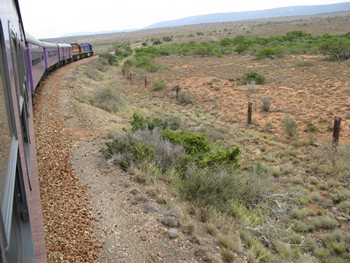 |
| Arid plains in the Eastern Cape interior |
Going through Toorwaterpoort ("magic water gorge") was the highlight of the morning. When the railway line was constructed early in the 20'th century, the engineers did not follow the gentle gradient of the nearby road to Willowmore. Instead, the track was routed along one side of the steep and winding Toorwaterpoort gorge. Over millions of years the Traka River has gouged this spectacular ravine through the 1000-metre high Swartberg mountain range. Unfortunately, while it provides some breathtaking scenery for the train passenger, the river is prone to occasional flash-floods ; over the years these have wreaked havoc with the railway line, which is no more than five metres above the floor of the gorge. In 1996 severe flooding in the gorge wrecked the tracks and the line was closed for two years while costly repairs were undertaken. You can clearly see where sections of track have been raised and protected with concrete bulwarks and stone enclosed in wire mesh. A more recent flash-flood in 2004 luckily did not cause any damage to the railway, so these repairs appear to have been effective.
Everybody crowded the large windows of the lounge car to take in the spectacular views as the train slowly wound its way through the gorge, the noise of the diesel engines reverberating from the 300-metre high cliffs on either side. It was mid-summer and very dry, with only scattered pools of water in the riverbed. These made for amazing reflections as we passed by, often with the cliff only centimetres from the side of the train. It is about ten kilometres from one end of Toorwaterpoort to the other, the tiny halt of Vondeling marking the eastern entrance to the gorge.
Shortly after exiting the gorge we passed Willowmore, a fairly prosperous town due to the relatively fertile farmland around it. From there it was a long haul to Klipplaat through dry, sun-baked plains, over the Groot River near Fullerton via two rattling metal bridges, and with a brief stop at the desolate siding of Humefield for a driver change. Willowmore and Klipplaat are the only two towns of any substantial size on the route between Oudtshoorn and Uitenhage, just outside Port Elizabeth, a distance of several hundred kilometres. Klipplaat used to be a busy railway junction - it is here that the main west-east railway line on which we were travelling meets the branch line northwards to Graaff-Reinet and Middelburg. The actual intersection is a curved triangle of rails just outside town, designed in such a way that trains coming from any direction can easily turn onto either of the other two tracks. These days the line to Graaff-Reinet is closed to traffic and abandoned, with rusted rails stretching away into the distance. The demise of railway traffic through the town has left Klipplaat poverty-stricken and desperate, with high levels of unemployment and crime.
Evidence of the resentment of the impoverished people of Klipplaat towards the well-heeled tourists trundling past them on the train was provided as we slowed down to negotiate the triangular rail intersection. While we were eating lunch several sizeable stones were thrown at the train and two windows were broken, one in each dining car. According to the train manager this is a fairly regular occurrence, which they are trying to resolve by visiting the community in an attempt to educate the people as to the long-term value of tourism. Apparently stoning of trains used to happen outside Oudtshoorn as well, but after intervention with the help of the police they managed to put a stop to it there.
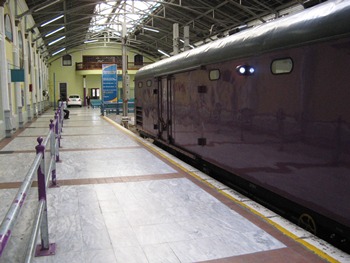 |
| Port Elizabeth station |
 |
As if we hadn't eaten enough after a massive breakfast and lunch, that afternoon there was also tea/coffee and chocolate cake in the lounge car! In fact, you can help yourself to tea or coffee at any time - during the day the bar of the lounge car doubles up as a self-service coffee shop. Hard to resist, but very obvious that frequent travelling on Premier Classe trains could be seriously damaging to your waistline ...
After Klipplaat we veered south-eastwards towards the coast. The terrain slowly changed from open, sparsely-vegetated plains to thick coastal bushveld. By late afternoon we were passing tiny villages with English settler names, such as Cockscomb, Glenconnor and Fitzpatrick's Valley (named after Sir Percy Fitzpatrick, author of Jock of the Bushveld), and soon we came to Uitenhage, Despatch and the outer suburbs of Port Elizabeth. The train chugged to a final stop in Port Elizabeth station at about 5 PM, an hour later than the scheduled arrival time. Port Elizabeth station is fairly small but spotlessly clean and delightful. The floor consists of gleaming, polished tiles and the walls are beautifully painted with murals depicting the history and settlement of Algoa Bay.
 |
| The boardwalk along the beach at Port Elizabeth |
Exiting the station we found a taxi to take us all to the hotel we'd booked into - the Town Lodge adjacent to The Boardwalk entertainment and casino complex, about five kilometres away on Marine Drive opposite Summerstrand Beach. It was a typically balmy Eastern Cape evening, with the sun still shining on a blue and sparkling sea, so after we'd checked into the hotel Karen, Mark and I dumped our bags in our rooms and crossed the street to the beach. After being cooped up on a train for over 24 hours it felt good to have sand between my toes and a fresh sea breeze on my face.
We walked west on the beach for some distance then turned back as the sun was setting. The Port Elizabeth beachfront has been extensively landscaped and beautified, and there is an attractive wooden boardwalk between the road and the beach that extends for miles along the coast. We strolled back to the hotel on the boardwalk, dodging the many runners, cyclists and dog-walkers also enjoying the late afternoon sunshine. After a quick shower at the hotel we walked across to The Boardwalk entertainment complex and rounded off a pleasant day with a relaxing alfresco dinner at one of the many restaurants there.
[Sunday 11 January] Sunday morning dawned bright and clear, chasing Karen and me out of bed early. We walked across the road to the beach where there was a flurry of early-morning activity. People were putting up signs, flags and bunting - it looked as though there was going to be a race or contest of some sort later. Surfskiing, swimming, lifesaving or perhaps a triathlon? Unfortunately we had a train to catch so we didn't have time to wait and see. Back at the hotel we had breakfast of coffee, pastries and muffins then packed and checked out. The taxi we'd arranged to collect us arrived at 8 AM, and within five minutes we were back at Port Elizabeth station - there's not much heavy traffic in Port Elizabeth at any time, but on Sunday mornings the roads are virtually empty.
 |
| Relaxing with a good book on the way home |
We should have been used to the Premier Classe experience by now, but we were again taken by surprize, because at the station we were greeted with coffee and muffins and told that a full breakfast would be served on the train after departure! So we needn't have eaten at the hotel and could have waited half an hour longer on the beach to see what was going on there. We boarded the train, dumped our gear in our three compartments then went straight to the dining car for another sumptuous breakfast. While we were quaffing our bacon and eggs the train pulled out of the station (it was about 8:45 AM) and chugged north-west through the suburbs of Port Elizabeth.
Initially we were on the same tracks that are used by MetroRail commuter trains in Port Elizabeth, although these don't run on Sundays. The suburban stations we passed without stopping looked clean and well-maintained. The line is double-track and electrified as far as Swartkops, at which point the tracks split - the right fork is the electrified mainline north to Bloemfontein and Johannesburg while our Cape Town-bound train took the left fork north-west on non-electrified single track rails. There was a brief stop in Uitenhage to pick up a couple of passengers ; Uitenhage is also the last stop served by local MetroRail trains from Port Elizabeth.
For the rest of Sunday we retraced our route from the previous day, via Klipplaat (no stone-throwing this time, thankfully), Toorwaterpoort, Willowmore and Oudtshoorn. There was another long stop in Oudtshoorn before we began the tortuous descent of the Montagu Pass, down to George and the coast. Montagu Pass has seven tunnels (ranging in length from 60 metres to 209 metres) and gradients as steep as 1:36 in places, and was the last section of railway between Port Elizabeth and Cape Town to be completed in 1913 - it took nearly three years to lay the 25 kilometres of track from George to the mountain summit at Topping. There is also a road over the Montagu Pass, built by convict labour between 1844 and 1848 ; the road is visible from the train as it twists and turns its way up the mountainside.
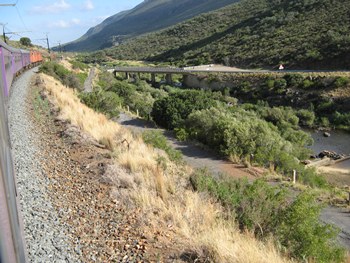 |
| Going through Nuwekloof Pass |
The sun was low and we were eating supper in the dining car as the train screeched down the pass, wheels screaming on the tight curves. The views across the rolling hills of the Outeniqua mountains were superb. After making an almost 180 degree turn we found ourselves heading eastwards on a south-facing slope, with the panoramic vista of the southern Cape spread out as far as the eye could see. We could see George far below us and the faint blue line of the Indian Ocean in the distance. Another U-turn at the aptly-named Horseshoe Bend turned the train completely around, and from this point on the gradient lessened as we descended more gradually through thick fynbos and into the outer suburbs of George. By the time we drew to a stop at George station it was nearly dark. We only stayed in George long enough for a foreign backpacker to disembark and walk off into the gloom. The train manager told me that this was quite unusual and not typically allowed, but the chap had booked at the last minute and asked to be let off at George. Because the train wasn't quite full he was given a berth and did not have to pay the full fare.
[Monday 12 January 2009] This morning we enjoyed our last breakfast on board the train as we rolled through the Western Cape wheat fields, once again enjoying the views in the Nuwekloof. We drew to a stop at platform 24 at Cape Town station at about 10 AM, and we all disembarked for the last time after a fantastic four days of "training". Walking towards the exit I noticed the striking green livery of a Rovos Rail train parked alongside us at platform 23. I strolled over to have a look and was suitably impressed with what I saw - Rovos Rail has a well-earned reputation as being the ultimate in luxurious train travel, but unfortunately a little beyond our budgets.
However, we had no complaints as our experience aboard a Premier Classe train was an extremely enjoyable and satisfying one (at a fraction of the cost of Rovos Rail), and I heartily recommend it to anybody who needs a relaxing break. No traffic worries or accommodation hassles, just fine food, attentive staff, interesting scenery and comfortable beds. What more could one ask for?